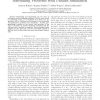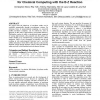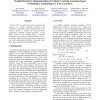2474 search results - page 1 / 495 » Solving Problems on Parallel Computers by Cellular Programmi... |
IPPS
2000
IEEE
13 years 9 months ago
2000
IEEE
Cellular automata can be used to design high-performance natural solvers on parallel computers. This paper describes the development of applications using CARPET, a high-level prog...
IPPS
2008
IEEE
13 years 11 months ago
2008
IEEE
—Scheduling and dispatching are two ways of solving production planning problems. In this work, based on preceding works, it is explained how these two approaches can be combined...
GECCO
2007
Springer
13 years 11 months ago
2007
Springer
We propose that the behaviour of non-linear media can be controlled automatically through coevolutionary systems. By extension, forms of unconventional computing, i.e., massively ...
FCCM
2005
IEEE
13 years 10 months ago
2005
IEEE
The CLA-EC is a model obtained by combining the concepts of cellular learning automata and evolutionary algorithms. The parallel structure of the CLA-EC makes it suitable for hard...
PDPTA
1996
13 years 6 months ago
1996
This paper describes a parallelization of the sequential dynamic programming method for solving a 2D knapsack problem where multiples of n rectangular objects are optimally packed...



